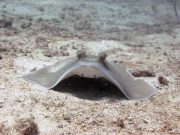Diving with Whiptail Stingrays
Lanta Marine Life | Dasyatidae
The Whiptail Stingrays are medium to large size rays with oval to diamond shaped disc-like bodies, and can often be seen while diving around Koh Lanta. The dorsal and caudal fins are missing, with the broadly expanded pectoral fins forming the distinctive body disc.
Disc width ranges from around 30 cm to more than 2 meters in larger species, with most of the 69 member species found in shallow tropical and subtropical seas around the world.
The upper body surface is usually grey to brown, sometimes patterned, with the lower surface usually whitish. The gills and mouth are found on the underside of the body.
As the name suggests, members of this family have long whip-like tails, with almost all having one or more saw-edged venomous barbs along the tail. The tail is always significantly longer than the body width.
The tail barbs can reach up to 20 cm in length, elevating when threatened, with the venom glands housed in two grooves on the underside. This powerful weapon is used exclusively for self defence.
The pectoral fins are used to stir up worms, crustaceans, and molluscs. Captured prey is overpowered and pinned to the bottom, before being scooped into the mouth and crushed by bands of small teeth lining the jaws.
Depending on their environment, whiptail stingrays are also known to eat jellyfish and bony fishes.
Since they are heavily preyed upon by a number of shark species, most whiptail stingrays spend a great deal of their time partially buried under the sand or mud on the seafloor with just their eyes protruding. This is considered primarily a defensive strategy rather than a stealthy way to surprise prey.
Whiptail stingrays are ovoviviparous; the embryos are retained in eggs within the mother's body until they are ready to hatch, they will hatch inside the mother and will be born alive and independent.
1 species found on this page:
Bluespotted (Kuhl's) Stingray
(Neotrygon Kuhlii)
The Khul's Stingray, Dasyatis kuhlii, also commonly known as the blue spotted stingray, has a flat greyish body disc, about 40cm in diameter, with scattered blue spots on the upper body. (not to be confused with the blue spotted ribbontail ray, Taeniura Lymma).
The eyes are yellow and are positioned to allow a wide angle of view. There is a darker mask-like pattern around the eyes, with this species belonging to the genus Neotrygon, the Maskrays. The snout is very short and angular.

Neotrygon Kuhlii @ Koh Bida
The tail is long, with very distinctive black and white bands towards the end. The two venomous saw-edged barbs along the tail elevate when threatened, each measuring 15 - 20 cm in adults.
The distinctive blue spots and bright tail colouration serve as a powerful warning to potential predators.
Some larger sharks and mammals will prey on younger smaller blue spotted stingrays as their barbs are smaller and less venomous.
Often seen resting in deeper water near the reef edge at several of the dive sites around Koh Lanta, blue spotted stingrays are usually found buried in the sand, with only the eyes and tail visible.
Blue spotted stingrays are usually solitary, occasionally forming small groups, and sometimes forming larger groups, called a Fever of Rays.

Bluespotted Stingrays @ Koh Haa
Blue spotted stingrays can birth up to 4 live pups at a time, measuring up to 15 cm in length.
Diving with Whiptail Stingrays around Koh Lanta
Scuba Diving & Snorkel Trips
If you'd love a chance to spot Whiptail Stingrays on one of our daily high season diving trips from Koh Lanta then send us an email to info@diveandrelax.com.
Join our high season speedboat dive trips to some of Thailand's best dive sites and enjoy small groups, short journey times, with a focus on great personal service, safety and fun.
Not yet a certified diver? Learn to Scuba Dive on Koh Lanta with the 3 day SSI Open Water Diver course.
Book online to save 10% on dive trips and scuba courses on Koh Lanta.
Find Out More
Indo-Pacific Marine Life Guides
- Allen, G., Steene, R., Humann, P., DeLoach, N. (2003) Reef Fish Identification, Tropical Pacific. Jacksonville, FL., USA: New World Publications, Inc., ISBN 1-878348-36-1.
- Humann, P., DeLoach, N., (2010) Reef Creature Identification, Tropical Pacific. Jacksonville, FL., USA: New World Publications Inc., ISBN 978-1-878348-44-9
- Debelius, H. (2013) Indian Ocean Reef Guide. Frankfurt, Germany: IKAN - Unterwasserarchiv, ISBN 978-3-939767-52-7.
- Debelius, H. (2004) Nudibranchs and Sea Snails, Indo-Pacific Field Guide. Frankfurt, Germany: IKAN - Unterwasserarchiv, ISBN 3-925919-51-1
- Erhardt, H., Knop, D. (2015) Corals Indo-Pacific Field Guide. Frankfurt, Germany: IKAN - Unterwasserarchiv, ISBN 3-925919-69-4.
- Veron J.E.N., Stafford-Smith M.G., Turak E. and DeVantier L.M. (2016). Corals of the World


